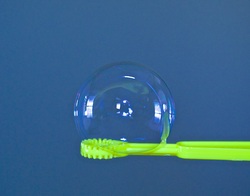 From childhood to adulthood, bubbles have never ceased to amaze me. From the simple bubble solution to magical air-filled bubbles that gently drift and softly swirl through the air, only to pop with a soft, fizzy, POP! It’s no wonder that children find them just as exciting and memorizing as I do. Because of the strong fascination of this age-old pastime, bubbles have become one of my favourite tools in speech and language therapy. It’s a playful pastime that is both motivating and entertaining for children of almost any age! I’m still discovering new and interesting ways to integrate bubbles into daily goals for the children I work with. Here are a few of my favourite ways to incorporate bubbles into daily routines to help build strong speech and language skills:
Even though your child may not be using words yet, you can still model words for them; and with the magical bubble wand in your hand, all eyes will be on you. Use single words and short phrases such as “More bubbles!” and “POP!”
Bubbles can also be used to teach...blowing bubbles! As simple as that sounds, most children aren’t born with the knowledge of how to blow bubbles. Blowing bubbles involves many different skills such as knowledge of cause and effect, the ability to imitate actions, and proper breath support, just to name a few! The important key in using bubbles effectively to help build speech and language skills is to be interactive with your child, and keep control of the bubbles. And of course, remember to have fun!
7 Comments
|
AuthorAlyssa Bergen is a Speech-Language Pathologist who understands the power of communication. She enjoys working with young children and seeing how their lives are positively shaped by successful communication. ArchivesCategories
All
|
